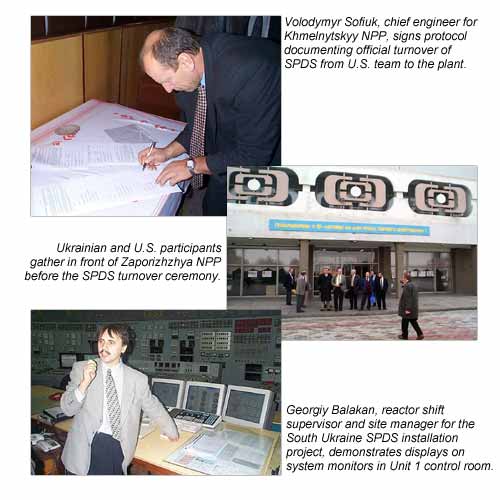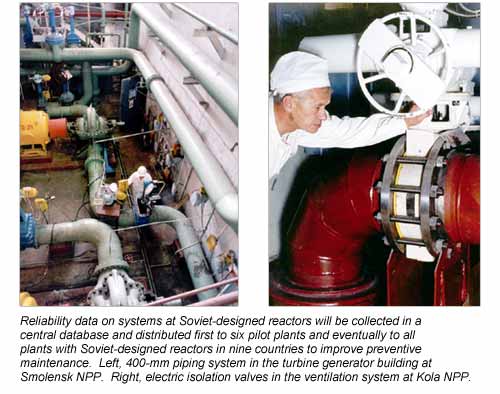
|
November 1999
Highlight |
Armenia Bulgaria Czech Republic Hungary |
Kazakhstan Lithuania Russia Slovakia |
Ukraine United States Cross-Cutting Activities Planned Activities |
Highlight
Ceremonies and signings mark official system turnovers at three Ukrainian plants
The U.S. team officially turned over safety parameter display systems (SPDSs) to three nuclear power plants in Ukraine this month. Team representatives from Westinghouse Electric Company, Burns & Roe Enterprises, Inc., and Pacific Northwest National Laboratory participated in turnover ceremonies at Zaporizhzhya, Khmelnytsky, and South Ukraine nuclear power plants (NPPs). These three plants were the first designated to receive SPDSs supplied by the U.S. team; they are the first of eleven eventual installations throughout Ukraine.

The first system turnover ceremony was held at Khmelnytskyy Unit 1 on October 29. Plant representatives included the chief engineer for the site, his deputy chief engineers, and instrumentation and control specialists. The official turnover was documented in a protocol, indicating acceptance of the system for pilot operation as required by Ukraine's State Nuclear Regulatory Administration. Organizations whose representatives signed the turnover protocol included Burns & Roe, Westinghouse, Westron, and Energoatom.
Turnover ceremonies and protocol signings were held also for Zaporizhzhya Unit 5 on November 1 and South Ukraine Unit 1 on November 3.
With the completion and turnover of these three pilot SPDSs, plus additional systems now being installed for completion by late January 2000, more than half of the eleven SPDS installations targeted are nearly done. The current schedule calls for all eleven systems to be installed and operational by 2002. (Norman Fletcher, DOE, 301-903-3275; Mike Durst, PNNL, 509-372-4698)![]()
WANO-MC approves central reliability database for soviet-designed reactors
A subproject under the World Association of Nuclear Operators-Moscow Center (WANO-MC) Reactor Safety Project initiative was approved to support the development of a centrally located safety component reliability database for Soviet-designed reactors. The WANO-MC Board of Governors granted the approval at its annual meeting in Sofia, Bulgaria, November 23. The board's approval allows the nine countries with Soviet-designed reactors access to a safety component reliability database that compiles operational equipment history from all of the participating nuclear power plants. This is a significant step in improving safety at these plants. It is the first time that data and lessons learned for safety equipment will be able to be shared formally among all Soviet-designed nuclear power plants.

Reliability databases collect information on the operations and malfunctions of the reactors' mechanical, electrical, and instrumentation systems important to safety. Once implemented, the availability of these reliability data to all Soviet-designed plants will be a significant enhancement to their safety. A key use of such data is in improving preventive maintenance programs. In addition, the data support probability risk assessments that examine risks and set priorities for safety improvements. The involvement of more nuclear power plants in the database improves the quality of the data.
The International Component Reliability Database is the culmination of efforts that began independently in Russia in 1997 and Ukraine in 1998, supported through cooperative safety efforts with the United States. As each country developed its separate database, care was taken to make the structures of the databases compatible with each other and with the generic reliability database maintained by the International Atomic Energy Agency. Meanwhile, other countries, including the Czech Republic, Hungary, Slovakia, and Lithuania, have developed similar databases, which also will be combined into the final database.
Meetings in September and October 1999 laid the groundwork for the WANO-MC-approved agreement that will eventually involve all 21 Soviet-designed nuclear power plants and 65 operating reactors. The October meeting, held at the Russian Institute for Nuclear Power Plant Operations (VNIIAES) in Moscow, involved some 70 representatives from the various plants and technical organizations. The plan for merging the existing Russian and Ukrainian databases was discussed.
Following the successful connection of the pilot plants to their respective plant database, the Russian and Ukrainian databases will be merged into a central data repository at the WANO-MC. Pilot plants then will be linked to the database via the existing WANO-MC telecommunications network. This linkage will allow each participating plant to access the database and will provide plant-specific data to be entered into the database. The plan is to eventually link all 21 Soviet-designed plants to the system. The timing of completion of the project depends on available funding. (Grigory Trosman, DOE, 301-903-3581; Thomas Vehec, PNNL, 509-372-4072)![]()